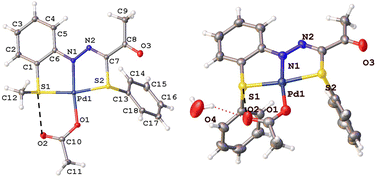Effect of chalcogen bonding interactions on molecular structures; theoretical and crystallographic studies on two palladium(ii) acetate complexes†
Abstract
Two palladium complexes, [Pd(L1)(OAc))] (1) and [Pd(L2)(OAc))] (2), have been synthesized by reacting Pd(OAc)2 and new thioetherazo (HL) ligands (HL = 2(RS)C6H4NH–N![[double bond, length as m-dash]](https://www.rsc.org/images/entities/char_e001.gif) C(COCH3)–SC6H5, R = C6H5 (HL1), CH3 (HL2)). The ligands and their complexes have been characterized by IR, NMR and UV-Vis spectroscopic techniques and their geometries have been confirmed by X-ray crystal structure analysis for complexes 1 and 2, and HL1 as well. The acetate group is coplanar with the coordination plane in both complexes, which is due to the S⋯O chalcogen bonding interactions. This conclusion is supported by the Quantum Theory of Atoms in Molecules (QTAIM) analysis of the electron density. The isomerism in the two complexes was investigated theoretically, and the calculations proved that the reported molecular structures in the crystals are the most stable isomers. The antitumor potential of the ligands and complexes was investigated preliminarily by applying an MTT assay on cancer and normal cell lines along with cisplatin as a standard anticancer drug. It was found that the two palladium(II) complexes are more cytotoxic toward cancer cells than their analogous ligands. Complexes 1 and 2 showed high activity toward human breast cancer cells (T47D) with IC50 values of 61.6 ± 12 and 72.3 ± 8.4 μM ml−1, respectively. However, complex 1 revealed some toxicity in a normal cell line (VERO). On the other hand, both complexes exhibited less potency in human colon cancer cells (HCT 116 cell line). These findings indicated that the antiproliferative activity is improved when the ligands (HL1–HL2) are integrated into the metal center.
C(COCH3)–SC6H5, R = C6H5 (HL1), CH3 (HL2)). The ligands and their complexes have been characterized by IR, NMR and UV-Vis spectroscopic techniques and their geometries have been confirmed by X-ray crystal structure analysis for complexes 1 and 2, and HL1 as well. The acetate group is coplanar with the coordination plane in both complexes, which is due to the S⋯O chalcogen bonding interactions. This conclusion is supported by the Quantum Theory of Atoms in Molecules (QTAIM) analysis of the electron density. The isomerism in the two complexes was investigated theoretically, and the calculations proved that the reported molecular structures in the crystals are the most stable isomers. The antitumor potential of the ligands and complexes was investigated preliminarily by applying an MTT assay on cancer and normal cell lines along with cisplatin as a standard anticancer drug. It was found that the two palladium(II) complexes are more cytotoxic toward cancer cells than their analogous ligands. Complexes 1 and 2 showed high activity toward human breast cancer cells (T47D) with IC50 values of 61.6 ± 12 and 72.3 ± 8.4 μM ml−1, respectively. However, complex 1 revealed some toxicity in a normal cell line (VERO). On the other hand, both complexes exhibited less potency in human colon cancer cells (HCT 116 cell line). These findings indicated that the antiproliferative activity is improved when the ligands (HL1–HL2) are integrated into the metal center.



 Please wait while we load your content...
Please wait while we load your content...